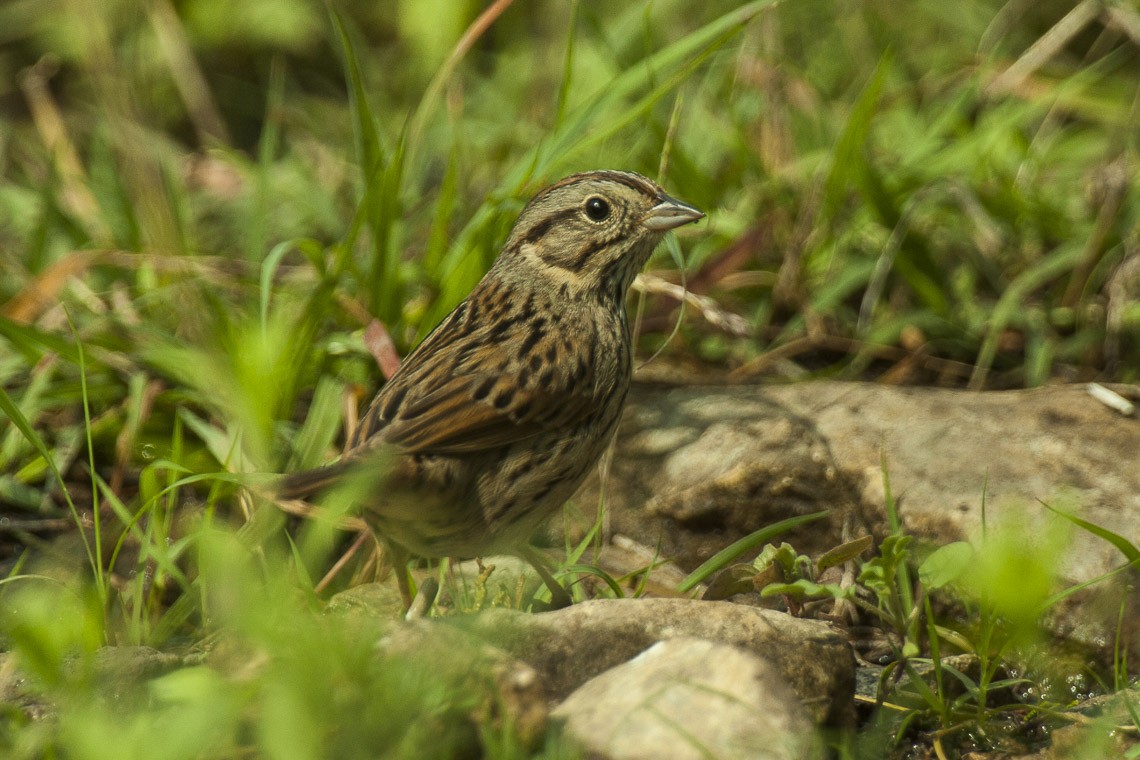Lincoln's Sparrow
A species of Round-tailed Sparrows Scientific name : Melospiza lincolnii Genus : Round-tailed Sparrows
Lincoln's Sparrow, A species of Round-tailed Sparrows
Botanical name: Melospiza lincolnii
Genus: Round-tailed Sparrows
Content
Description People often ask General Info
 Photo By Francesco Veronesi , used under CC-BY-SA-2.0 /Cropped and compressed from original
Photo By Francesco Veronesi , used under CC-BY-SA-2.0 /Cropped and compressed from original Description
Adults have dark-streaked olive-brown upperparts and a light brown breast with fine streaks, a white belly, and a white throat. They have a brown cap with a grey stripe in the middle, olive-brown wings, and a narrow tail. Their face is grey with brown cheeks, a buffy mustache, and a brown line through the eye with a narrow eye ring. Males and females are alike in plumage. They are somewhat similar in appearance to the song sparrow although smaller and trimmer with finer breast streaks. Juveniles strongly resemble juvenile swamp sparrows with a streaky chest and not yet buffy breast, but Lincoln's sparrows rarely have a unicolored crown like the swamp sparrow. Adult measurements: Length: 5.1-5.9 in (13-15 cm) Weight: 0.6-0.7 oz (17-19 g Wingspan: 7.5-8.7 in (19-22 cm) 
Size
13-15 cm (5.25-6 in)
Colors
Brown
Gray
White
Life Expectancy
7 years
Nest Placement
Ground
Clutch Size
3 - 5 eggs
Number of Broods
10 - 13 days
Nestling Period
10 - 11 days
Feeding Habits
Lincoln's Sparrow's diet variably includes insects such as beetles, flies, caterpillars, and spiders, and small seeds from weeds and grasses. With seasonal variations, they forage on the ground in dense vegetation, scratch to uncover food, and may visit feeders. Adults consume more spiders, feeding chicks more plant material and insects.
Habitat
Lincoln's Sparrow typically reside in lush, dense vegetation near water sources. Preferring cooler climates and altitudes ranging from lowland thickets to mountainous meadows, lincoln's Sparrow thrive in environments with ample plant cover such as willows, alders, aspens, and cottonwoods. They seek out damp habitats with thick underbrush, including muskeg and brushy bogs, during breeding season, and migrate to warmer regions with dense tropical forests, pine-oak woods, and scrubby pastures in winter months.
Nest Behavior
The female lincoln's Sparrow constructs the nest by first creating a small depression, then weaving the nest over 2-3 days. Parental care involves the female laying and incubating eggs while both parents tend to the young.
Nest Characteristics
Lincoln's Sparrow's nest is typically located on the ground or slightly elevated within thickets of willow or birch. It is about 4 inches in diameter and 2 inches tall, consisting of a cup-shaped structure crafted from willow bark, dried sedges, and grasses, and lined with soft plant materials.
Dite type
Insectivorous
People often ask
General Info
Feeding Habits
Bird food type
Bird Feeder Type

Platform
Sounds
Song
Recording location: United States
Song
Recording location: United States
Call
Recording location: United States
Behavior
Lincoln's Sparrow exhibit a secretive and skulking lifestyle, primarily foraging close to the ground while adeptly using cover. When not feeding on insects or seeds, they may perch in low vegetation, communicating their territory vocally. Notable for their direct flight with a distinctive tail posture upon landing, lincoln's Sparrow have unique mating rituals involving wing fluttering by females. Socially, lincoln's Sparrow establish temporary monogamous pairings during breeding, thereafter becoming solitary or occasionally mingling with other sparrow species during migration and winter months. The females' evasive nesting tactics further highlight their elusive nature.
Distribution Area
Their breeding habitat is subalpine and montane zones across Canada, Alaska, and the northeastern and western United States, although they are less common in the eastern parts of their range. They are found mainly in wet thickets, shrubby bogs, and moss-dominated habitats. They prefer to be near dense shrub cover and their nests are well-concealed shallow open cups on the ground under vegetation. At lower elevations, they can also be found in mixed deciduous groves, mixed shrub-willows, and black spruce-tamarack bogs. They primarily use the ground and base of willows for foraging, whereas they use tall trees and willow branches for singing. During migration, they live in thickets and bushes, particularly in riparian zones. They use lowlands such as the Great Plains and Great Basin, as well as urban and suburban habitats in the east. Their migration period starts between May 13th to 30th and lasts until August 20th to September 20th. Their southern habitats over the winter include tropical evergreen and deciduous forests, arid and humid pine-oak forests, Pacific swamp forests, and arid subtropical scrub. Their wintering range extends from the southern United States down to Mexico and northern Central America; they are passage migrants over much of the United States, except in the west. In 2010, a Lincoln's sparrow was observed for the first time in the Dominican Republic, and there have also been several records of this species in montane regions of Haiti. However, the skulking behavior of this bird and their preference for densely-covered habitats makes it difficult to accurately describe the full range of this species. 
Species Status
Not globally threatened.
Scientific Classification
Phylum
Chordates Class
Birds Order
Perching birds Family
New world sparrows Genus
Round-tailed Sparrows Species
Lincoln's Sparrow